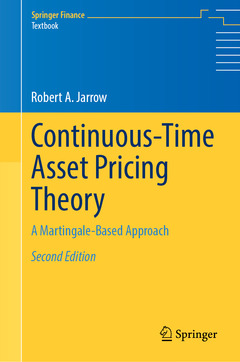Description
Continuous-Time Asset Pricing Theory (2nd Ed., 2nd ed. 2021)
A Martingale-Based Approach
Springer Finance Textbooks Series
Author: Jarrow Robert A.
Language: English
Subject for Continuous-Time Asset Pricing Theory:
456 p. · 15.5x23.5 cm · Hardback
Description
/li>Biography
/li>Comment
/li>
Asset pricing theory yields deep insights into crucial market phenomena such as stock market bubbles. Now in a newly revised and updated edition, this textbook guides the reader through this theory and its applications to markets. The new edition features ?new results on state dependent preferences, a characterization of market efficiency and a more general presentation of multiple-factor models using only the assumptions of no arbitrage and no dominance.
Taking an innovative approach based on martingales, the book presents advanced techniques of mathematical finance in a business and economics context, covering a range of relevant topics such as derivatives pricing and hedging, systematic risk, portfolio optimization, market efficiency, and equilibrium pricing models. For applications to high dimensional statistics and machine learning, new multi-factor models are given. This new edition integrates suicide trading strategies into the understanding of asset price bubbles, greatly enriching the overall presentation and further strengthening the book?s underlying theme of economic bubbles.
Written by a leading expert in risk management, Continuous-Time Asset Pricing Theory is the first textbook on asset pricing theory with a martingale approach. Based on the author?s extensive teaching and research experience on the topic, it is particularly well suited for graduate students in business and economics with a strong mathematical background.
Robert Jarrow is the Ronald P. and Susan E. Lynch Professor of Investment Management at Cornell’s SC Johnson College of Business (Ithaca, New York) and director of research at Kamakura Corporation. He is a co-creator of the Heath–Jarrow–Morton (HJM) model, the reduced form credit risk model, and the forward price martingale measure.
Creates the foundation for the use of machine learning and high dimensional statistics in multi-factor models
Offers a deeper understanding of asset price bubbles
Sequentially studies arbitrage pricing theory, derivatives pricing, portfolio theory, and equilibrium pricing
These books may interest you

Financial Asset Pricing Theory 67.55 €



